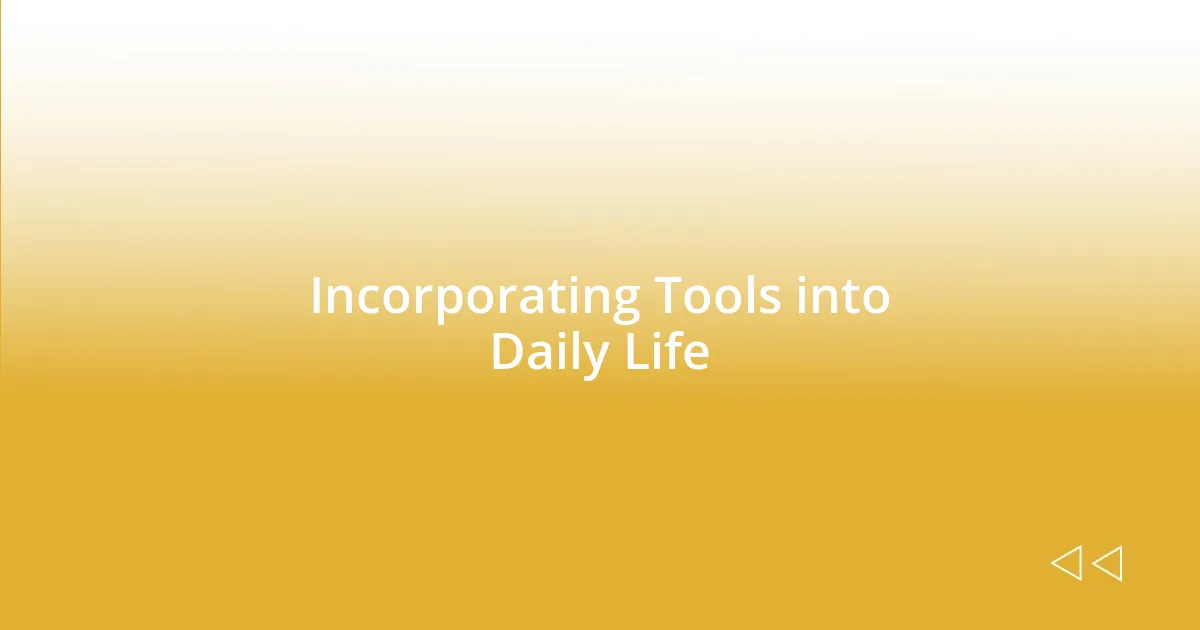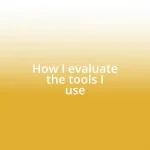Key takeaways:
- Mindfulness is about embracing the present moment, using techniques like focused breathing to reduce stress and enhance clarity.
- Essential tools for mindfulness, such as meditation apps, journals, and dedicated spaces, facilitate deeper practice and emotional understanding.
- Incorporating mindfulness into daily life, such as through mindful walking or setting reminders, can lead to significant long-term benefits, like reduced anxiety and improved emotional resilience.
- Reading mindfulness literature, like works by Thich Nhat Hanh and Tara Brach, can provide valuable insights and personal growth opportunities.

Understanding Mindfulness Practices
When I first stumbled upon mindfulness practices, it felt like finding a hidden gem in my chaotic life. I remember sitting in a crowded café, overwhelmed by noise and distractions, when a simple breathing exercise transformed my perspective. Have you ever found peace in the midst of chaos? That moment was when I realized that mindfulness isn’t about escaping reality but rather embracing the present with all its messiness.
At its core, mindfulness is about being fully aware and engaged in the here and now. It’s fascinating how a few focused breaths can shift your mindset from stress to clarity. I still recall the first time I practiced mindfulness while walking in my neighborhood. Instead of rushing through my route, I became conscious of each step, the sound of leaves crunching beneath my feet, and the crisp air on my skin. Isn’t it amazing how the simple act of walking can morph into a meditative experience?
Mindfulness practices are all about tuning into our thoughts and feelings without judgment. I often find myself reflecting on how judgment towards my feelings used to create barriers in my emotional well-being. What if we allowed ourselves to observe our emotions like clouds passing in the sky? Acknowledging their presence without getting swept away is liberating, offering a sense of freedom I never knew I needed. This approach has fundamentally enriched my understanding of mindfulness, allowing me to cultivate a deeper connection with myself and my surroundings.

Importance of Essential Tools
Essential tools for mindfulness serve as powerful allies in navigating the complexities of daily life. I remember my first experience with a guided meditation app; it was like having a personal coach in my pocket, helping me focus and find calm even on my busiest days. Can you imagine the relief of having a structured path to follow when your mind feels like it’s racing?
Utilizing tools such as journals, meditation apps, or calming music can greatly enhance our mindfulness practice. I often found writing my thoughts down transformed my chaotic feelings into more manageable reflections. It’s remarkable how breaking down my emotions on paper can help me understand what I’m truly feeling, creating space for deeper introspection.
Moreover, I’ve discovered that having a dedicated space for mindfulness practices—whether it’s a cozy corner of my home or a beautiful spot outdoors—often makes all the difference. I’ve felt the profound impact of having a physical reminder to pause and reconnect with myself. What about you? Do you have a favorite place for your mindfulness moments? Creating that intentional space can invite tranquility into our lives, encouraging us to prioritize our mental well-being.
| Essential Tool | Benefits |
|---|---|
| Meditation Apps | Guided sessions help structure practice and provide a sense of direction. |
| Journals | Facilitates emotional expression and clarity of thought. |
| Calming Music | Enhances relaxation and sets the tone for mindfulness. |
| Dedicating a Physical Space | Encourages consistency and creates a serene environment for practice. |

My Journey to Discover Tools
While embarking on my mindfulness journey, I was initially unsure of where to begin. One day, I found myself wandering through a bookstore and stumbled upon a book dedicated to mindfulness techniques. The pages felt alive, filled with insights that resonated deeply with my chaotic thoughts. It was as if the author was speaking directly to my struggles, guiding me toward tools that could help me navigate my internal landscape.
I realized that finding the right tools was like tuning an instrument; each one added a unique note to my practice. Here are a few essentials that became my companions on this journey:
- Mindfulness Books: They offer wisdom and strategies to deepen practices and inspire personal growth.
- Meditation Cushions: A comfy spot can transform your practice, making it feel like a welcoming retreat rather than a chore.
- Nature Walks: Immersing myself in nature helped me connect with my surroundings while clearing my mind.
- Mindful Breathing Techniques: Simple but effective tools that ground me in the present moment, calming my racing thoughts.
- Accountability Buddies: Sharing this journey with friends created a quilt of support and motivation I hadn’t anticipated.
In sharing these experiences, I’ve come to appreciate how essential it is to not only discover but also adapt tools that resonate personally. Each tool has its place, and together, they have woven a fabric of mindfulness that has enriched my life immeasurably.

Evaluating Mindfulness Apps
When I first delved into mindfulness apps, I felt like a kid in a candy store. Each app promised calmness and clarity, but I wasn’t sure which direction to take. I ended up trying a few different ones, and I quickly learned the importance of user experience. If an app wasn’t intuitive, it often led to frustration rather than relaxation. Have you experienced that too? It’s essential to find an app that feels like an extension of your practice, one that fits seamlessly into your routine.
I gravitated towards apps that offered guided meditations featuring soothing voices and varied themes. One app, for instance, let me explore gratitude practices, which significantly shifted how I viewed my daily life. I would wake up each morning and listen to a short session, and it became a beautiful ritual that set a positive tone for my day. It’s fascinating how just a few minutes can change your mindset—have you found a practice that resonates with you in a similar way?
Another crucial aspect of evaluating mindfulness apps is checking for personalization. The ability to customize my sessions based on mood or time available allowed me to feel more connected to the process. I remember once logging in feeling overwhelmed and choosing a five-minute breathing exercise, which provided instant relief. Tailored experiences not only enhance engagement but also make it easier to maintain a consistent practice. What features do you seek in an app, and do you find them available in your current choice?

Recommended Books for Mindfulness
One book that truly transformed my mindfulness practice is “The Miracle of Mindfulness” by Thich Nhat Hanh. I remember curling up in my favorite chair, sipping tea as I absorbed his gentle wisdom. His storytelling infused with practical exercises encouraged me to embrace the present moment. Have you had an experience where a book felt like a personal conversation? This one certainly did for me.
Another noteworthy read is “Wherever You Go, There You Are” by Jon Kabat-Zinn. I was initially drawn in by the title—it’s a reminder that no matter how far we wander, peace is found within. As I turned each page, I found myself reflecting deeply on my own life, feeling a connection to Kabat-Zinn’s journey. It sparked the question: is there a place in your heart that you often overlook? This book helped me pinpoint those areas, guiding me to nurture them.
Lastly, I can’t recommend “Radical Acceptance” by Tara Brach enough. I had a profound moment while reading it, where I realized I’d been harshly critiquing myself instead of embracing my feelings. Brach’s use of personal anecdotes made me feel less alone. It’s like she was holding up a mirror, asking, “What if you treated yourself with compassion instead?” That perspective shift was invaluable on my path to mindfulness.

Incorporating Tools into Daily Life
Incorporating mindfulness tools into my daily life was a revelation. I started by designating specific moments in my routine to practice mindfulness—like taking a few conscious breaths during my morning coffee. That simple act of being present transformed such a mundane activity into a cherished ritual. Have you ever noticed how a small shift in perspective can create a ripple effect in your day?
I found that integrating mindfulness tools doesn’t have to be forced. For instance, I began using a mindful walking approach while commuting. Instead of zoning out on the journey, I focused on the sensations of my feet touching the ground and the rhythm of my breath. It’s remarkable how these simple moments became opportunities for reflection. Have you considered how daily activities could serve as mindfulness practice for you?
Tech tools also played a critical role in this integration. I started setting reminders on my phone to prompt short mindfulness breaks, like guided stretching or a minute of deep breathing. Initially, it felt odd to have technology facilitate such natural practices, but soon it became a game-changer. How do you incorporate reminders or nudges into your routine to keep mindfulness at the forefront? I’ve found that these small adjustments have led to substantial benefits, creating pockets of peace in my otherwise busy days.

Long-Term Benefits of Mindfulness Tools
The long-term benefits of mindfulness tools are profound, extending far beyond the moment of practice. I remember a time when I felt overwhelmed by stress, and the effects of incorporating mindfulness into my routine were transformative. Over the months, I noticed a significant decrease in my anxiety levels, as if a heavy weight had been lifted. Have you ever experienced that liberating moment when you realize you can manage everyday challenges with greater ease?
In my journey, I found that mindfulness tools enhanced my emotional resilience. For instance, when faced with unexpected obstacles, I began responding with a calm clarity rather than reacting impulsively. It was like discovering a new part of myself, one that could navigate life’s ups and downs with grace. How do you handle stress now? Perhaps, like me, you’re seeking ways to cultivate patience and understanding toward yourself and others.
The practical insights gained from these tools have also improved my relationships. While practicing active listening—a mindfulness technique—I felt more connected to my loved ones. Simply being present during conversations created a deeper sense of intimacy and trust. I often reflect on how our interactions can shift with just a little presence. Isn’t it fascinating how the act of being truly present can change the quality of our connections with others? Experiences like these remind me that mindfulness isn’t just about individual growth; it’s about enriching our shared experiences, too.















